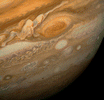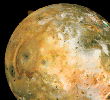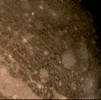
 Jupiter
Jupiter

Planet Profile
Mass .............................................. 1.90 X 1027 kg Diameter .............................................. 142,800 km Mean density ............................................. 1.31 gm/cm3 Escape velocity ........................................ 59,500 m/s Average distance from Sun (AU)........................... 5.203 Rotation period (length of day in Earth hours)............. 9.8 Revolution period (length of year in Earth years)........ 11.86 Obliquity (tilt of axis).................................. 3.08° Orbit inclination ......................................... 1.3° Orbit eccentricity (deviation from circular)............. 0.048 Mean surface temperature .................................. 120 °K (cloud tops) Visual geometric albedo (reflectivity).................... 0.44 Atmospheric components............................ 90% hydrogen 10% helium 0.07% methane

 Full Disk (Enlarge view)
Full Disk (Enlarge view)Jupiter is an example of a "gas giant": that is, all gas giants are similar to Jupiter in composition. Gas giants are much larger than terrestrial-type planets such as the Earth or Mars, and Jupiter is the largest of the gas giants. It is 11 times Earth's diameter, and has 318 times its mass. In fact, Jupiter contains well over double the mass of all the other planetary bodies in the solar system combined. (Isaac Asimov once said, accurately, that the solar system consists of the Sun and Jupiter and a little debris.) This color-enhanced image of Jupiter was taken by Voyager 1.
 Jovian System (Enlarge view)
Jovian System (Enlarge view)Voyager 1 took this photo of Jupiter and two of its satellites, Io on the left and Europa on the right. Io orbits about 217,000 miles above Jupiter (the Great Red Spot is shown behind Io); Europa orbits about 372,000 miles above Jupiter's clouds. Although both satellites have about the same brightness, Io's color is different from Europa's. Io's equatorial region shows two shades of red, indicating different surface materials.
 The Great Red Spot (Enlarge view)
The Great Red Spot (Enlarge view)This dramatic view of the Great Red Spot and its surroundings was taken February 25, 1979, when Voyager 1 was 5.7 million miles from Jupiter. An atmospheric system or storm larger than the Earth and more than 300 years old, the longevity of the Great Red Spot remains a mystery. Swirling, storm-like features possibly associated with wind shear can be seen both to the left and above the Red Spot.
The Galilean Satellites
The four "Galilean" satellites of Jupiter are named after Galileo, who first saw them in 1609. Each roughly the size of our Moon, they were the first worlds to be discovered by telescope.
 Io (Enlarge view)
Io (Enlarge view)
Unlike most small bodies in the solar system, Io has virtually no surface craters, because its surface is very active volcanically. Its volcanism is driven by tidal stresses induced by Jupiter and the next satellite out, Europa. Io's surface materials are rich in sulfur compounds. Black sulfur lakes dot Io's surface, some of them as hot as 400 °F. Scientists think that the bright patches seen here may
be due to sulfur dioxide ice and gas jetted from fractures in the surface. In the upper left, a volcanic explosion can be seen silhouetted against dark space. Solid material was blasted to an altitude of about 100 miles, requiring an ejection velocity from the volcanic vent of about 1200 miles per hour.
 Europa (Enlarge view)
Europa (Enlarge view)
Europa, close in size to our Moon, is thought to have an ice surface 62 miles thick which overlies a silicate surface. The complex array of streaks indicates that the crust has been fractured. The lack of mountains or craters on Europa is consistent with an ice surface. In contrast to its icy neighbors, Ganymede and Callisto, Europa has few impact craters. One possible candidate is the small feature near the center of this image with radiating rays and a bright circular interior. The relative absence of features and low topography suggests the crust is young.
 Ganymede (Enlarge view)
Ganymede (Enlarge view)
The interior of Ganymede is thought to consist of a rocky core about the size of our Moon, surrounded by a thick covering of ice roughly equal in mass. Complex tectonic patterns have formed on the icy crust, possibly by tectonic forces that squeeze and wrinkle the surface. This color reconstruction of part of the northern hemisphere of Ganymede was made from pictures taken at a range of 194,000 miles by the Voyager spacecraft. It shows a dark, densely cratered area bounded on the south by lighter, less cratered grooved terrain. The large bright circular features are probably the remnants of old, large craters. About the size of Mercury, Ganymede is 5280 km (3168 mi) in diameter.
 Callisto (Enlarge view)
Callisto (Enlarge view)
Callisto, composed of rock and ice, is covered with numerous impact craters. The largest of these is Valhalla Basin, a 1650-mile-wide multi-ring impact basin near the top of the image. Craters on Callisto appear as bright and dark spots whose morphology changes. Newer craters appear as sharply defined bright and dark spots. Over time, older craters appear as more diffuse splotches.
